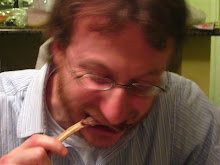


If I had remembered to take a picture of the uncut whole side of the fish there would be a more complete record. But I didn't, so the photos start with the cure, skipping the most important step--getting a good fish. This is the rest of the fish that was used in the New Orleans recipe below. To recap, it's half of a fall Coho Salmon from the Copper River in Alaska.
A few things about salmon. First, I'm not going to comment on farmed salmon. I've already taken up enough space with the three pictures. For the rest of this post, unless otherwise indicated, salmon refers to fresh wild salmon. Second, the infamous Copper River. I believe the hype about Copper River salmon is as much about great marketing as anything else. I've eaten great wild salmon caught elsewhere in Alaska, Washington, Oregon, and even Michigan. It's all been good. Maybe there's some merit to the claims of the exceptional taste of the hardworking salmon caught in the Copper River, I don't know. When I'm lucky enough to be able to pick between different types of salmon I'm not too concerned about their provenance. I pick which looks best regardless of where it's from. I don't discriminate based on point of origin (I may take fishing methods/fishery management into account though.). Third, while I'm not concerned about the fish's domicile, I do pay attention to what type of salmon it is, which generally means choosing between Chinook (King), Coho (Silver), and Sockeye (Red). They're all good.
Chinook salmon are large and have a high fat content. It's also usually the most expensive type. Coho are generally smaller, and that's what I used here. Sockeyes are my favorite. I like the color and flavor of Sockeyes, and as long as its not overcooked I don't think there is any better variety. The preference is personal, and I don't suspect everyone agrees. But in my experience, which has included bartering with an Alaskan fisherman for huge fillets of salmon flash frozen in cryovac bags to buying a fresh from the water Chum salmon (variety not recommended) out of the back of a guy's pickup truck at a gas station, I always go back to the Sockeye. Incidentally, if it's frozen and thawed well it's amazing how long salmon can stay stored in the freezer without dramatically decreasing in quality (I got my salmon fix through long Midwest winters by buying a whole scaled and gutted fish in season, portioning it out and freezing it at home, and then thawing portions from the freezer when the mood arose.).
Okay, enough about that. The top picture is of the majority of one side of a filleted salmon cut into four pieces. It was cut once along the length, dividing the thick portion and thin portion (belly) of the fillet (The thick portion takes a little bit longer to cook through.), and then again across the width of each half. When I first did this, I learned to cut the fish into small individual portions at this point. Using four big pieces here was easier to handle than lots of little pieces, but, as the edges/crusts are likely the best part, in the future I'll go back smaller pieces.
The salmon is covered in a curing mixture made up of equal parts salt and sugar. I need to get approval from the folks who gave me the recipe before releasing the details, i.e. types of salt/sugar. As you can see, it will start to leak, otherwise known as cure. I let it sit like this for about an hour before draining the dish and brushing off the majority of the mixture with a paper towel.
Next, it's off to the smoker, where it smoked at a very low temp for around three and a half hours. I converted the charcoal smoker to electric by putting an inexpensive single electric burner in the area designated for coal, and placing a pie pan on the burner element to hold the smoking mixture. I kept the burner on high the whole time. It still didn't get too hot. The electric smoker makes it easy and helps alleviate any temptation to peak at the fish. It's constantly cooking, slowly.
After a few hours I flake off some of the fish to check if it's done. Also, if it starts oozing white stuff, that's a good indicator. I think the white stuff is fat coming up, but I could have sworn I read that it was tissue or muscle or something (I didn't do very well in biology.). Once done let it come to room temp, wrap in plastic wrap, bag it (it smells smokey), and enjoy at your leisure. It's great with crackers and in omelets, and I'm thinking about throwing it into the food processor to make some kind of mousse (I don't claim to have made up the idea.) . . . there are lots of things to do with it.





No comments:
Post a Comment